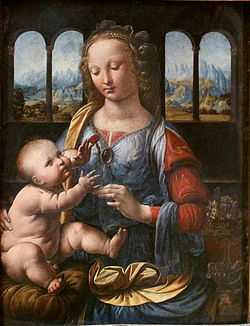Madonna of the Carnation
| Italian: Madonna del Garofano | |
|---|---|
 | |
| Artist | Leonardo da Vinci |
| Year | 1478–1480 |
| Type | Oil on panel |
| Dimensions | 62 cm × 47.5 cm (24 in × 18.7 in) |
| Location | Alte Pinakothek, Munich |
The Madonna of the Carnation, a.k.a. Madonna with vase or Madonna with child, is an oil painting by Leonardo da Vinci created around 1478-1480 (Renaissance). It is permanently displayed at the Alte Pinakothek gallery[1] in Munich, Germany since 1889 after it was in private ownership.
The central (and centered) motif is young Virgin Mary with her naked Baby Jesus on her lap. Mary is seated and wears precious clothes and jewellery. With her left hand, she is holding a carnation (interpreted as a healing symbol). The faces are put into light while all other objects are darker, e.g. the carnation is covered by a shadow. The child is looking up, the mother is looking down — there is no eye contact. The setting of the portrait is a room with two windows on each side of the figures.
Originally this painting was thought to have been created by Andrea del Verrocchio but subsequent art historians agree that it is Leonardo's work.
Madonna and Child was a common motif in Christian art during the Middle Ages. This painting is the only work by Leonardo which is permanently on display in Germany.
References and sources
- ↑ Room IV ("Italian Renaissance paintings"), Inventory No. 7779
External links
- Leonardo da Vinci: anatomical drawings from the Royal Library, Windsor Castle, exhibition catalog fully online as PDF from The Metropolitan Museum of Art, which contains material on Madonna of the Carnation (see index)
![]() Media related to Madonna with clove by Leonardo da Vinci at Wikimedia Commons
Media related to Madonna with clove by Leonardo da Vinci at Wikimedia Commons
| ||||||||||||||||||||||||||||||||||||||||||||||